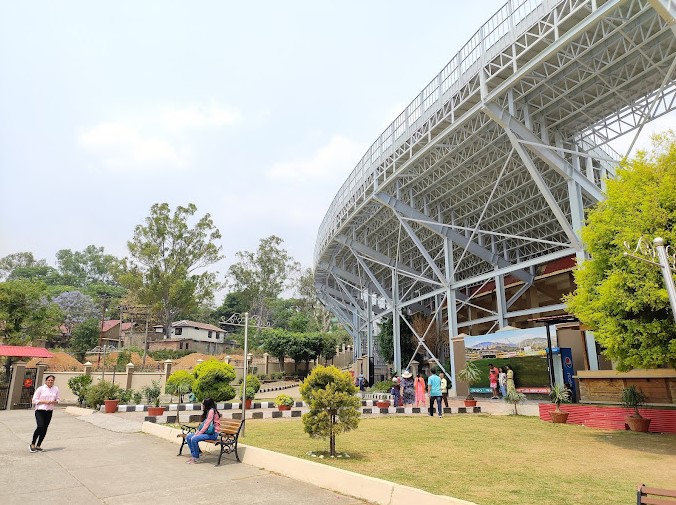Dharamshala Cricket Stadium: The Himachal Pradesh Cricket Association (HPCA) Stadium, nestled in the picturesque town of Dharamsala, is one of India’s most scenic cricket venues. Surrounded by the towering Dhauladhar mountain range, the stadium provides a stunning backdrop for international cricket matches. Since its inauguration in 2003, the HPCA Stadium has hosted numerous domestic and international games, including famous series and the Indian Premier League (IPL).
Table of Contents
Dharamshala Cricket Stadium: One of the key factors that affect the gameplay and strategy of a match is the boundary length. A stadium’s boundary dimensions can significantly influence a batsman’s scoring opportunities, a bowler’s tactics, and the overall nature of the match. In this article, we will explore the boundary dimensions at the HPCA Stadium and how they affect the game of cricket.
Dharamshala Cricket Stadium: Understanding the Boundary Dimensions at HPCA Stadium
Dharamshala Cricket Stadium: The boundary length of any cricket ground is a critical factor that shapes the outcome of the game. At the HPCA Stadium, the boundary lengths are as follows:
- Straight Boundaries: Approximately 76 meters from the center of the pitch.
- Square Boundaries: Around 65 meters.
- Fine Leg & Third Man Boundaries: Between 57 to 58 meters.
Dharamshala Cricket Stadium: These dimensions place the HPCA Stadium in a unique category where the boundaries are neither excessively short nor too long, offering a balanced challenge for both batsmen and bowlers. The variation in the lengths from different sides of the ground ensures a dynamic playing field where different tactics can be employed.
Boundary Length Comparison with Other Cricket Grounds
Dharamshala Cricket Stadium: To give a clearer context, here is a comparison of the boundary lengths at various iconic cricket grounds across the globe. This table highlights the different distances that players encounter in different settings:
| Stadium Name | Straight Boundary (m) | Square Boundary (m) |
|---|---|---|
| HPCA Stadium, Dharamsala | 76 | 65 |
| Melbourne Cricket Ground (MCG) | 70 | 70 |
| Eden Gardens, Kolkata | 66 | 60–66 |
| Lord’s Cricket Ground, London | 61 | 56 |
| Old Trafford, Manchester | 65 | 65 |
Dharamshala Cricket Stadium: As we can see from the table, the HPCA Stadium’s boundary dimensions are closer to the mid-range, offering a balanced playing field.
How Boundary Dimensions Impact Gameplay
1. Batsmen’s Approach
Dharamshala Cricket Stadium: The boundary length directly affects a batsman’s strategy. With shorter square boundaries of about 65 meters, batsmen have the opportunity to focus on aggressive shots such as square cuts, pull shots, and lofted drives. These dimensions encourage batsmen to play aggressively and target the boundaries frequently.
Dharamshala Cricket Stadium: However, the longer straight boundaries of 76 meters force batsmen to be more precise with their shot selection. To clear the longer straight boundaries, players need better timing, power, and technique. This creates an interesting contrast, where batsmen must choose between trying to clear the boundary straight or targeting the shorter square regions for boundaries.
Dharamshala Cricket Stadium: In limited-overs formats like T20 and ODI, these boundary dimensions can lead to high-scoring games, as batsmen exploit the shorter square boundaries while also adjusting their strategy for the longer straight ones.
2. Bowling Strategy
Dharamshala Cricket Stadium: Bowling tactics vary greatly depending on the boundary dimensions. Bowlers at the HPCA Stadium must adjust to the fact that while the square boundaries are shorter, the straight boundaries are relatively long.
For example:
- On shorter square boundaries, bowlers need to bowl tighter lines, often on the off-side, to limit the batsmen’s ability to cut and pull the ball for boundaries. Fast bowlers often bowl bouncers, while spinners might opt for variations to restrict scoring.
- On longer straight boundaries, bowlers can afford to bowl fuller deliveries and aim for yorkers to prevent sixes. The length of the straight boundary encourages slower balls, cutters, or even bouncers to make hitting into the deeper regions harder for batsmen.
This dynamic forces bowlers to be versatile and creative in their tactics, making the match more interesting for both players and spectators.
3. Field Placement
The field placements also vary based on the boundary dimensions. With shorter square boundaries, captains may position more fielders on the square leg side, including deep square leg and deep point positions. On the longer straight side, deep mid-off and deep mid-on fielders are placed to cover potential sixes.
4. Impact on Game Formats
The HPCA Stadium, with its varied boundary dimensions, affects different game formats differently:
- T20 Matches: The shorter square boundaries encourage high-scoring games, where batsmen can go for big hits. The combination of shorter square boundaries and longer straight boundaries makes the game fast-paced.
- One Day Internationals (ODIs): Here, batsmen look to rotate the strike more, but the shorter square boundaries still encourage hitting for boundaries, making the games competitive.
- Test Matches: While the shorter square boundaries offer opportunities for attacking cricket, Test matches at the HPCA Stadium tend to be more about strategy and patience, with batsmen needing to focus on building partnerships rather than going for boundary-hitting.
Historical Performance at HPCA Stadium
The HPCA Stadium has hosted several iconic matches over the years, from domestic tournaments to international series. The boundary dimensions have played a role in some thrilling contests.
In ODIs, high scores are often achieved, with teams reaching totals in excess of 300 runs, particularly when teams utilize the shorter square boundaries. In contrast, the longer straight boundaries require careful shot selection, and getting the ball over them is often a challenge for batsmen.
The Balanced Challenge of HPCA Stadium
The boundary dimensions of the HPCA Stadium offer a balanced challenge for both batsmen and bowlers. The combination of shorter square boundaries and longer straight boundaries means that players must adjust their strategies based on the format and the situation of the game. While batsmen enjoy opportunities for aggressive stroke play, particularly in the square regions, the longer straight boundaries require careful and controlled shot-making.
As the HPCA Stadium continues to host international and domestic cricket matches, its boundary dimensions will remain a vital part of the strategies employed by both teams. Whether it’s a high-scoring T20, a competitive ODI, or a patient Test match, the HPCA Stadium will always offer an exciting cricketing experience.

